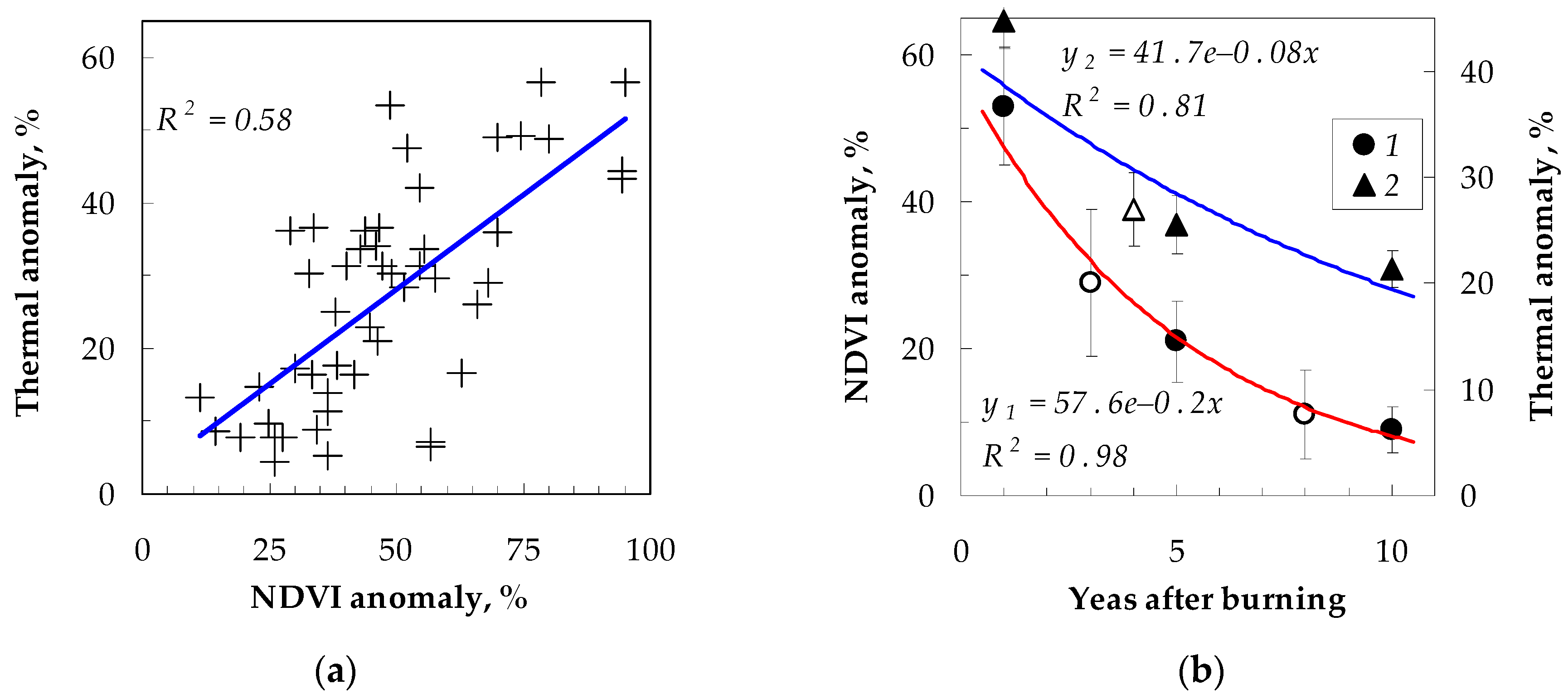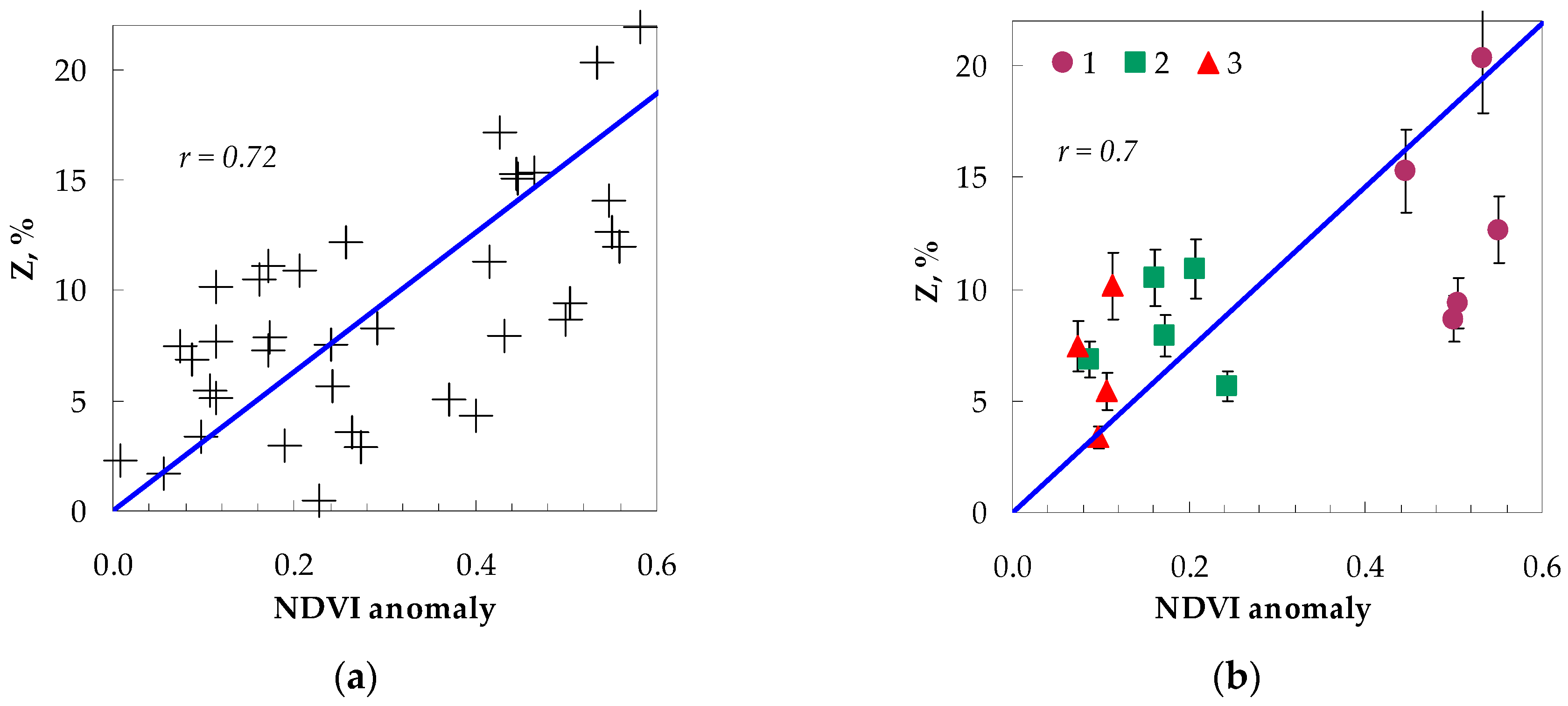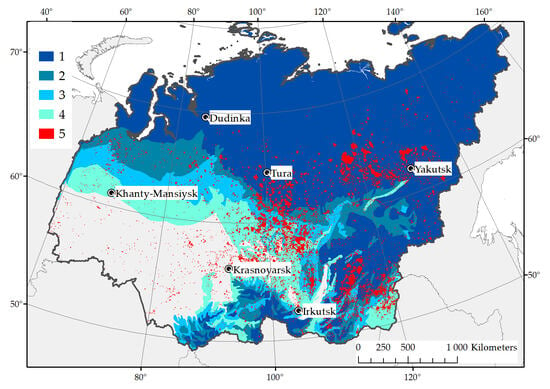1. Introduction
Wildfire impact is the main factor that strongly affected the state of boreal ecosystems of Siberia. The post-fire changes in the vegetation cover in the larch forests of Central Siberia form conditions for significant changes in thermal balance. These changes can affect the seasonal thawed layer and its dynamics. Significant and long-term post-fire effects are well-documented in the permafrost zone of Siberia [
1,
2,
3,
4,
5]. A number of the problems associated with vegetation cover disturbances have been discussed, such as degradation of seasonal thawed layer of permafrost as well as variation of temperature and water regimes of soils [
3,
6,
7]. Post-fire changes in the thermal balance can result in the disturbance of the “transitional layer”, which protects the upper horizons of permafrost [
8]. Given the vast nature of the geographical area to be managed, satellite techniques are the primary means for wildfire monitoring in most parts of the boreal forest zone of Russia. Evaluation of the effects of fires on Siberian ecosystems also requires the usage of remote data.
The main aims of this study are (i) to perform a quantitative analysis of thermal anomalies in fire-damaged areas of the permafrost zone of Siberia and its dynamics according to the stages of post-fire succession, and (ii) to obtain estimates of the depth of the seasonally thawed layer under conditions of excessive heat flux on the surface based on numerical modeling technique.
2. Experiments
2.1. Study Area
The study area included the territory of Evenkia (central part of Siberia), covering the territory from 62° to 66° N and from 96° to 107° E (
Figure 1). This region belongs to the Central Siberian flat-mountainous taiga region of the boreal taiga zone. Siberian larch (
Larix sibirica,
Larix gmelinii) is the dominant species in the forest stands. The study area belongs to the continuous permafrost zone according to the Circum-Arctic permafrost and ground ice map by the National Snow and Ice Data Center [
9]. Large-scale wildfires are typical for the territory, which are detected by satellite monitoring only and are not served by fire protection systems.
2.2. Materials and Method
Retrospective multispectral materials of Terra and Aqua/MODIS for the period 2006–2018, as well as information on wildfires in the format of geo-information polygonal layer [
10], were used for post-fire plots selection. High resolution imagery (15–30 m) of Landsat/ETM/OLI (Enhanced Thematic Mapper/Operational Land Imager) and Sentilel-2 were used for wildfire geometry precise estimating. Multispectral data from Terra/Aqua and the retrospective imagery allows evaluation of long-term changes using both the “vegetation” channels of the spectrum and the thermal range. The characteristics of the post-fire area were determined by analyzing of spectral features in the range of λ
1 = 0.620–0.670 μm, λ
2 = 0.841–0.876 μm (product MOD09GQ) and in thermal band of λ
3 = 10.780–11.280 μm (product MOD11A1)/(L2G and L3
https://lpdaac.usgs.gov/dataset_discovery/modis) [
11,
12].
Temperature, albedo and Normalized Difference Vegetation Index (NDVI) dynamics were investigated in total for 50 post-fire plots under different stages of succession (1, 2, 5 and 10 years after burning) in comparison with non-disturbed vegetation cover sites under the same natural conditions. Across the entire set of initial data, a 10-day average was performed taking into account the recovery succession stages. Dates of fires and post-fire stages were controlled using the attribute information of the wildfire databank [
10].
Variety of the thaw depth of the permafrost layer (Z) was estimated depending on the thermal anomaly at the surface and vegetation recovery stage. Numerical modeling was based on the Stefan solution of the heat conduction equation for the depth of the seasonal thawing layer [
4,
13,
14]:
where
ρ is the density (kg/m
3), T is the temperature of the surface (
Ts) and the temperature of permafrost layer (
Tf),
x is the depth of the layer (m),
λ is the thermal conductivity coefficient (W/(m °C)) for the thawing layer (
λ1) and permafrost layer (
λ2), τ is the duration of heating,
l is specific heat of fusion (J/kg),
u is the volumetric water content of soil (%).
3. Results and Discussion
Over the study area, fires were recorded on a total area of 12.743 MHa during 22 years of available instrumental observations. This is more than γ > 12.0% of forested areas; relative burned area (RBA) was 0.51 ± 0.18% per year. Average RBA for Siberia is 1.19% [
15]. For comparison, RBA is 0.56% for the forests of Western Canada [
16]. Significant “accumulative” effect from fires provokes large-scale anomalies of vegetation cover and thermal balance (
Table 1).
On the post-fire sites aged one year, the value of NDVI was typically 50 ± 8% comparing to the non-disturbed plots. The deviation of NDVI (21 ± 7%) abnormality was two times lower than the control values on the post-fire sites aged five years. Fire sites with an age of 10 years do not differ significantly from the control in terms of NDVI, which is caused by success restoration of on-ground vegetation cover. The mean deviation from control values did not exceed 9% with a significant dispersion of σ = 5%. Anomalies in vegetation cover are lost during the next 5–7 years after fire. However, the process of tree stands restoration is much longer, up to 50 years [
5,
7,
17].
For the same plots, vegetation anomalies correlate with data on mid-summer thermal anomalies as well (
Figure 2a). The maxima of temperature abnormality stay significant more than 10–15 years after a wildfire (
Table 1,
Figure 2). Absolute temperature maxima (ΔT) were fixed in the range of 7.0 ± 1.5 °C during mid-summer for plots of burnt larch forest of Central Siberia. This is 20–40% higher than the temperature of undisturbed sites. The rate of loss of thermal anomalies was 2.5 times lower than the rate of vegetation restoration according to NDVI. The coefficients of exponential approximation are −0.08 and −0.2 (
Figure 2b).
Numeric simulation and field measurements [
5,
7,
18] fix the average statistical norm of seasonal thawing of active soil layer at 0.6–2.0 m under conditions similar to the region of interest. As shown by the results of numerical simulation, the excess heat flux on the surface causes an increase in depth thawing (Z) on average by 10–20% (
Figure 3) relative to the average statistical norm. Thawing of the soil profile is possible for an additional 0.5 m in depth under the conditions of stable anticyclone that are usually observed over the central part of Siberia during summer for up to 20–30 days [
19] and an excessive insolation of the surface. Despite the fact that the maximum of the thermal anomaly is fixed in the middle of summer (
Table 1), the maximum of thawing depth should be expected in August. The delay in temperature dynamics with depth of soil profile should be taken into account [
20].
The results of satellite monitoring [
4] and a number of ground-based experiments [
7] allow us to state the long-term (15–25 years) effects of thermal anomalies on the post-fire sites of the permafrost zone. On post-fire plots, the NDVI values are restored 3 to 5 years after the fire. But surface temperature anomalies still can be considered as statistically significant 10–15 years after burning. The low rate of vanishing of the thermal anomaly makes it possible to consider this factor of long-term influence on the state of the soil and the permafrost as one of the most significant. A similar effect was observed, in particular, in Alaska [
6]. The obtained results are also consistent with the data for Russian forests [
3,
21]. This should be taken into account when assessing the state of the forests, tree mortality or monitoring of regeneration processes in the forests of the permafrost zone using satellite methods [
22]. Temperature fields restored using the satellite data can be considered as the basis for monitoring the condition of forests of the permafrost zone of Siberia.
Considering the predicted climate changes, the toughening of fire regimes and the increased fire activity in the forests of the permafrost zone [
15,
19,
23,
24,
25], the integral effect of post-fire thermal anomalies will strengthen and is likely to grow increasingly.
4. Conclusions
Changes in thermal regimes of post-fire areas in Central Siberia are accompanied by an abnormal increase in average temperatures of the soil surface by ΔT = 7.2 ± 1.3 °C. This is 20–40% higher than the temperature of undisturbed sites. The NDVI values are restored 3 to 5 years after the fire. The rate depends on the regeneration of the vegetation cover. The partial regeneration of vegetation covers does not compensate the changes, which lead to long-term temperature abnormalities. The thermal balance of post-fire sites with disturbed vegetation cover remain affected for more than 15 years.
It was found that the abnormal temperatures on a significant area of the permafrost zone can result in a seasonal increase in the thawing depth of the soil by 10–20% when compared with the mean normal value.
Vast post-fire disturbances (currently up to 12% of total forested area per the last two decades) of the vegetation cover in the northern regions of Siberia have a significant effect on the temperature regime of the “ground cover”–“soil”–“permafrost layer” boundary layer. A more detailed study of post-fire effects is important for predicting the response of boreal ecosystems to the fire impact, which currently tends to increase.
The low rate of the thermal anomaly lost, at least in the first 10 years after the fire, makes it possible to consider this factor of long-term influence on the state of the seasonal thawed soil layer as one of the most significant. This technique and remote sensing data could be used for determining the stability of permafrost ecosystems.
Author Contributions
E.P. and T.P. conceived and designed the experiments; E.P. and T.P. performed the experiments; E.P., O.M. and T.P. analyzed the data; E.S., O.P., K.K. and A.D. contributed reagents/materials/analysis tools; E.P. wrote the paper.
Acknowledgments
This research was supported by the Russian Foundation for Basic Research (RFBR), project No 17-04-00589 “Radiometric method for quantitative analysis of soils structure organization”, RFBR and Government of the Krasnoyarsk region and Krasnoyarsk krai Foundation for Research and Development Support, project No 18-41-242003 “Modeling and satellite monitoring of effects from thermal anomalies of the underlying surface in the seasonally thawed soil layer of the permafrost zone of Siberia”.
Conflicts of Interest
The authors declare no conflict of interest.
Abbreviations
| MODIS | Moderate Resolution Imaging Spectroradiometer |
| NDVI | Normalized Difference Vegetation Index |
| RBA | Relative Burned Area |
| ETM | Enhanced Thematic Mapper |
| OLI | Operational Land Imager |
References
- Ivanova, G.A. Extreme fire-endangered seasons in forests of Evenkia. Siber. Ecolog. J. 1996, 3, 29–34. (In Russian) [Google Scholar]
- Sofronov, M.A.; Volokitina, A.V.; Kajimoto, T. Ecology of wildland fires and permafrost: Their interdependence in the northern part of Siberia. In Proceedings of the Eighth Symposium on the Joint Siberian Permafrost Studies between Japan and Russia in 1999, Tsukuba, Japan, 19–20 January 2000; pp. 211–218. [Google Scholar]
- Anisimov, O.A.; Sherstiukov, A.B. Evaluating the effect of environmental factors on permafrost in Russia. Kriosfera Zemli (Earth’s Cryosph) 2016, 2, 90–99. (In Russian) [Google Scholar]
- Ponomarev, E.I.; Ponomareva, T.V. The Effect of Postfire Temperature Anomalies on Seasonal Soil Thawing in the Permafrost Zone of Central Siberia Evaluated Using Remote Data. Contemp. Probl. Ecol. 2018, 11, 420–427. [Google Scholar] [CrossRef]
- Knorre, A.A.; Kirdyanov, A.V.; Prokushkin, A.S.; Krusic, P.J.; Buntgen, U. Tree ring-based reconstruction of the long-terminfluence of wildfires on permafrost active layer dynamics in Central Siberia. Sci. Total. Environ. 2019, 652, 314–319. [Google Scholar] [CrossRef] [PubMed]
- Brown, D.R.N.; Jorgenson, M.T.; Kielland, K.; Verbyla, D.L.; Prakash, A.; Koch, J.C. Landscape Effects of Wildfire on Permafrost Distribution in Interior Alaska Derived from Remote Sensing. Remote Sens. 2016, 8, 22. [Google Scholar] [CrossRef]
- Bezkorovaynaya, I.N.; Borisova, I.V.; Klimchenko, A.V.; Shabalina, O.M.; Zakharchenko, L.P.; Il’in, A.A.; Beskrovny, A.K. Influence of the pyrogenic factor on the biological activity of the soil under permafrost conditions (Central Evenkia). Vestnik KrasGAU 2017, 9, 181–189. (In Russian) [Google Scholar]
- Desyatkin, R.V.; Desyatkin, A.R. Temperature Regime of Solonetzic Meadow-Chernozemic Permafrost-Affected Soil in a Long-Term Cycle. Eurasian Soil Sci. 2017, 50, 1301–1310. [Google Scholar] [CrossRef]
- Brown, J.; Ferrians, O.J.; Heginbottom, J.A.; Melnikov, E.S. Circum-arctic map of permafrost and ground ice conditions, Ver. 2. 2002. Boulder, Colorado USA: National Snow and Ice Data Center. Digital media. Available online: https://nsidc.org/data/ggd318 (accessed on 4 February 2019).
- Ponomarev, E.I.; Shvetsov, E.G. Satellite survey of forest fires and GIS methods for data alignment. Issled. Zemli Kosmosa (Rem. Sens.) 2015, 1, 84–91. (in Russian). [Google Scholar] [CrossRef]
- Wan, Z.; Hook, S.; Hulley, G. MOD11A1 MODIS/Terra Land Surface Temperature/Emissivity Daily L3 Global 1km SIN Grid V006. NASA EOSDIS LP DAAC 2015. [Google Scholar] [CrossRef]
- Vermote, E.; Wolfe, R. MOD09GQ MODIS/Terra Surface Reflectance Daily L2G Global 250m SIN Grid V006. NASA EOSDIS LP DAAC 2015. [Google Scholar] [CrossRef]
- Arzhanov, M.M.; Eliseev, A.V.; Demchenko, P.F.; Mokhov, I.I. Simulation of dynamics of temperature and hydrological regime of near-surface permafrost using climatic data (reanalysis). Kriosfera Zemli (Earth Cryosphere) 2007, 11, 65–69. (In Russian) [Google Scholar]
- Vinogradov, Y.B.; Semenova, O.M.; Vinogradova, T.A. Hydrological modeling: Calculation of the dynamics of thermal energy in the soil profile. Kriosfera Zemli (Earth Cryosphere) 2015, 19, 11–21. (In Russian) [Google Scholar]
- Ponomarev, E.I.; Kharuk, V.I.; Ranson, J.K. Wildfires Dynamics in Siberian Larch Forests. Forests 2016, 7, 125. [Google Scholar] [CrossRef]
- de Groot, W.J.; Cantin, A.S.; Flannigan, M.D.; Soja, A.J.; Gowman, L.M.; Newbery, A. A comparison of Canadian and Russian boreal forest fire regimes. For. Ecol. Manag. 2013, 294, 23–34. [Google Scholar] [CrossRef]
- Kharuk, V.I.; Dvinskaya, M.L.; Ranson, K.J. Spatio-temporal dynamics of fires in the larch forests of the northern taiga of Central Siberia. Rus. J. Ecol. 2005, 5, 1–10. (In Russian) [Google Scholar]
- Abaimov, A.P.; Sofronov, M.A. The main trends of post-fire succession in near-tundra forests of central Siberia. In Fire in Ecosystems of Boreal Eurasia; Goldammer, J.G., Furyaev, V.V., Eds.; Kluwer Academic Publishers: Dordrecht, The Netherlands, 1996; pp. 372–386. [Google Scholar]
- Valendik, E.N.; Kisilyakhov, E.K.; Ryzhkova, V.A.; Ponomarev, E.I.; Danilova, I.V. Conflagration fires in taiga landscapes of Central Siberia. Geogr. Natur. Resour. 2014, 35, 41–47. [Google Scholar] [CrossRef]
- Desyatkin, R.V.; Desyatkin, A.R.; Fedorov, P.P. Temperature regime of taiga cryosoils of Central Yakutia. Kriosfera Zemli (Earth Cryosphere) 2012, 16, 70–78. (In Russian) [Google Scholar]
- Lebedeva, L.S.; Semenova, O.M.; Vinogradova, T.A. Calculation of the depth of seasonally melted layer in various landscapes of Kolyma water-balance station based on Gidrograf hydrological model. Kriosfera Zemli (Earth Cryosphere) 2015, 19, 35–44. (In Russian) [Google Scholar]
- Bartalev, S.A.; Stytsenko, F.V.; Egorov, V.A.; Loupian, E.A. Satellite-Based Assessment of Russian Forest Fire Mortality. Lesovedenie (For.) 2015, 2, 83–94. (In Russian) [Google Scholar]
- Vaganov, E.A.; Arbatskaya, M.K. The history of climate and fire frequency in the central part of Krasnoyarsk krai. 1. Climate conditions of a season and distribution of fires during a season. Siber. Ecol. J. 1996, 3, 9–18. (In Russian) [Google Scholar]
- Flannigan, M.; Stocks, B.; Turetsky, M.; Wotton, M. Impacts of climate change on fire activity and fire management in the circumboreal forest. Glob. Chang. Biol. 2009, 15, 49–560. [Google Scholar] [CrossRef]
- Kharuk, V.I.; Dvinskaya, M.L.; Petrov, I.A.; Im, S.T.; Ranson, K.J. Larch Forests of Middle Siberia: Long-Term Trends in Fire Return Intervals. Reg. Environ. Chang. 2016, 8, 2389–2397. [Google Scholar] [CrossRef] [PubMed]
© 2019 by the authors. Licensee MDPI, Basel, Switzerland. This article is an open access article distributed under the terms and conditions of the Creative Commons Attribution (CC BY) license (https://creativecommons.org/licenses/by/4.0/).











